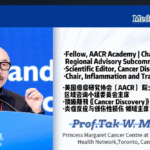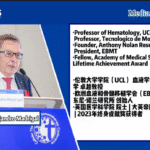Editor’s Note: China, Japan, South Korea and other East Asian countries share a high prevalence of hepatobiliary and pancreatic tumors, yet current treatment options still fall short of clinical needs. Clinicians and patients face similar diagnostic and therapeutic challenges, underscoring the importance of trilateral academic exchange and collaboration to share practical experience and initiate cooperative clinical studies. On October 24–25, 2025, the 13th Federation of Asian Clinical Oncology (13th FACO) Annual Meeting was held in Shanghai, aiming to promote clinical oncology cooperation and innovation among China, Japan, South Korea, and the broader Asian region. During the meeting, Oncology Frontier invited Prof. Chao Chen from Jinling Hospital, Medical School of Nanjing University (Eastern Theater Command General Hospital) to discuss the latest advances in the diagnosis and treatment of hepatobiliary and pancreatic cancers presented at FACO, as well as future directions for the field and prospects for regional collaboration in Asia.
Oncology Frontier: Which academic presentations or exchanges at this year’s FACO meeting left the deepest impression on you? How might they influence your clinical practice?
Prof. Chao Chen:
Attending the FACO meeting offered me many insights and inspirations. In the field of hepatobiliary medicine, which I specialize in, I saw numerous studies from China as well as relevant work from Japan and South Korea. However, much remains to be done in terms of integrating resources and conducting global, multicenter, or real-world studies.
During the meeting, I had a conversation with a surgical expert from Fukuoka, Japan. He too is extremely busy and expressed similar concerns about balancing heavy clinical workloads with scientific research—an issue many clinicians share. At the same time, most of my previous academic exchanges have been geographically limited. FACO provides a platform to broaden these exchanges and collaborations across Asia, helping improve clinical decision-making and, ultimately, benefiting patients.
Oncology Frontier: What topic did you present at this FACO meeting? Could you summarize the main messages of your report?
Prof. Chao Chen:
I was honored to share progress from a line of research our center has long pursued on medical treatments for hepatobiliary cancers. In addition to conducting prospective, randomized, multicenter clinical trials, our center also performs real-world studies. This is because randomized controlled trials place strict—and sometimes overly stringent—requirements on enrollment and patient characteristics. Many real-world patients do not meet these criteria but still require treatment. Real-world studies therefore better reflect frontline clinical practice.
For liver cancer treatment, immunotherapy is now a foundational approach and has achieved important advances. However, primary liver cancer—particularly in advanced stages—is distinct from other solid tumors: most patients have underlying liver disease, and reliable biomarkers predicting therapeutic efficacy or adverse events are lacking. Moreover, the response rate to immune monotherapy in liver cancer remains below 20%, and even combined treatment with tyrosine kinase inhibitors (TKIs) achieves a response rate of under 35%, meaning the majority of patients still do not benefit.
Our current study draws on a large body of real-world data on immunotherapy for liver cancer. We collected 41 relevant parameters—including prior systemic therapy, surgical or locoregional treatments, tumor burden, metastatic sites, and laboratory variables—to construct a predictive model of treatment response. We also developed a user-friendly online calculator to estimate an individual patient’s likelihood of responding to immunotherapy.
Additionally, we are studying whether patients who progress on immunotherapy can continue treatment, factors predicting adverse events, and the effects of combining immunotherapy with radiotherapy or interventional procedures. More than 1,200 patients have been enrolled so far, but this remains a single-center effort. We hope to leverage the FACO platform to collaborate with domestic and international experts, expand the cohort, and add external validation—to generate stronger evidence and bring greater benefit to patients.

(Figure 1. Parameters included in the liver cancer immunotherapy prediction model)
Oncology Frontier: Based on your experience participating in clinical studies across Asia, what measures do you think are needed to facilitate smoother study execution?
Prof. Chao Chen:
Our center was one of the earliest in China to promote and participate in clinical research, and we have conducted or are currently conducting more than 300 clinical studies. From my experience, the success of a study largely depends on the scientific rigor of the protocol. Strong leadership from the principal investigator—in areas such as study-flow design, eligibility criteria, and statistical methodology—is crucial.
Equally important are the overall expertise of the research team, the quality of study execution, and participant management. Effective communication with patients can improve adherence and reduce dropout rates.
Many centers conducting clinical studies are major national institutions that receive patients from across the country. It is essential to ensure that participants can attend follow-up visits as scheduled, receive study treatment on time, and have adverse events promptly monitored and managed. Any issues arising during the study must be communicated in a timely manner with multidisciplinary teams, study designers, and sponsors so corrections can be made.
Abstract of Prof. Chao Chen’s FACO Report
A Novel High-Accuracy Nomogram to Predict Individual Outcomes for Patients With Advanced Hepatocellular Carcinoma Treated With PD-1 Inhibitors
Objective: To develop a nomogram capable of effectively identifying hepatocellular carcinoma (HCC) patients who are suitable candidates for immunotherapy and stratifying their risk levels.
Methods and Results: This retrospective study analyzed 328 HCC patients treated with PD-1 inhibitors between January 2019 and December 2022. Univariable and multivariable Cox regression analyses were used to identify prognostic factors. A new nomogram was then constructed based on independent predictors and evaluated using the Harrell concordance index (C-index), receiver operating characteristic (ROC) curves, calibration plots, and decision curve analysis (DCA). Kaplan–Meier curves were applied to estimate progression-free survival (PFS) and overall survival (OS) across risk groups.

Figure 2. Study inclusion/exclusion criteria and model development process
Survival Analysis: For PFS, treatment sequence, progression involving bone or lymph-node metastases, and Child–Pugh class were significant prognostic factors. For OS, significant factors included BCLC stage, Child–Pugh class, ascites, ECOG performance status, prior surgery, progression involving lymph-node metastases, and the neutrophil-to-lymphocyte ratio (NLR).
The PFS model achieved a C-index of 0.657 (0.609–0.705), matching its performance in the validation cohort (0.657 [0.582–0.733]). The OS model showed C-indices of 0.787 (0.748–0.826) in the training cohort and 0.671 (0.606–0.736) in the validation cohort. Calibration and DCA curves indicated strong accuracy and clinical usefulness. Significant differences in OS and PFS were observed between the low- and high-risk groups defined by the nomogram (P < 0.0001).

(Figure 3. Predictive performance of the model for OS in training and validation cohorts)
Conclusion:
This prognostic model—based on baseline clinical characteristics and treatment-related factors—demonstrates reliable performance in predicting survival benefits for patients with intermediate or advanced HCC undergoing immunotherapy. It is simple, practical, and has strong potential for clinical application.


